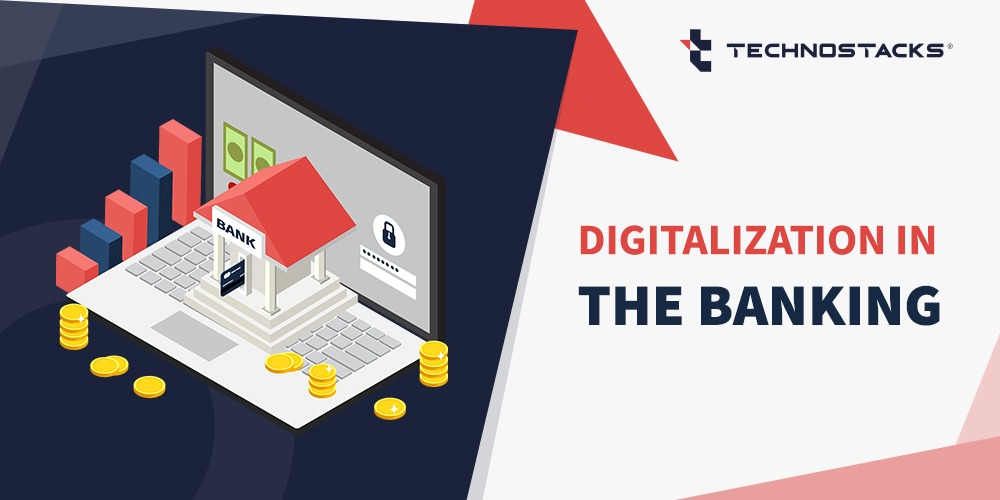Key Advantages of Digitization in Banking
Digitalization has turned the world upside down for almost all industries that form our everyday ecosystem. With a truckload of opportunities coming their way, enterprises now have tremendous room for growth. This essential merit comes from the easy and targeted customer reach. So, technology has certainly put forward a radical baby in terms of digitalization. While there is no doubt it has heavily impacted several sectors, we’re here to look at digitalization in the banking sector.
Banking is one of the very first sectors that witnessed the storm of digitalization. Machine learning in banking helps in fraud detection, Transactions went online more efficiently than ever, and there was so much more. However, it was shocking to see that several popular banks are very new to the list of digitalization. Most of these names were trailing behind until last year. Nevertheless, digitalization has opened new doors for the banking sector as well as its customers. So, let us take a look and explore the significant benefits of digitalization for banking institutions.
What are the key benefits and advantages of digitalization in banking?
The moment the question is put forward, there is no challenge finding a couple of answers that just fit right. This makes it pretty clear that the banking sector has seen many goods come out of digitization. However, if we have to talk to the very details, here are five major ways digitization has been advantageous to banking.
-
- Increased customersIf there’s one thing we cannot deny, it is the increased customer base that digitization brings to a sector. The banking domain has been no exception to this simple rule. An increasing number of people are relying every day on online banking solutions. The contrast of slow and cumbersome traditional banking also works in favor of digital banking. However, digitization has increased the customer base in the banking sector.While Fintech Benefits for the Banking sector, you can see a great change in everyday processes. Increasing the consumer base is one of the most noteworthy changes that digitalization in banking has brought around and arguably one of the best.
- Enhanced efficiencyA common question that makes its way to us is: Why is digitization necessary for banking? The advantage of efficiency answers the problem better than any other benefit. In a world that believes in speed and accuracy, digitization in banking has introduced both to entirely new levels. Banking processes are now conducted with a lot more ease and efficiency. As a simple process, digitization has changed the entire mathematics and art of banking by bringing in ease, efficiency, and extra productivity on the table.Examples of digitization in banking are seen in essential processes such as electronic signatures, smartphone-based banking applications, quicker transactions, and so much more. So, you can say that digitalization has brought around enhanced efficiency in banking processes. This seems to be working well for banks as well as customers.
- A user-friendly experienceIf we take a stroll towards the artistic side of digitalization regarding banking, we see that it has crafted a unique, user-friendly experience that never existed before. While banking earlier was symbolic of a slow and tiring queue that never ends, it now feels like a few simple clicks.Banking now flaunts a user-friendly garb and has become a lot more desirable and efficient. This scenario was not the case until late and has been a massive convenience to many across the globe. There is no room to question the actual place of digitization in this scenario.
This confirms that the impact of digitization on the banking sector has been trailblazing and undeniable. After considering public behavior, spending patterns and preferences, and other essential data, the banking sector now seems to have reached the vantage point after decades. If it wasn’t for effective digitization, would we still be looking at the same world?
- Data-driven decisionsDigitization has induced the “pragmatic” and “accurate” element in sectors it has touched. For example, if we talk about digitization and banking, most significant decisions are now data-driven. The great thing about data-driven decisions is that they are less likely to fire back as they have been carefully collected from a well-studied demographic.Several technologies have emerged to help banks make better decisions based on what exactly their customer base requires. Such a grass root level change wouldn’t have been easily possible without digitization. One other way digitization has fallen to rescue the banking sector is by helping them with the right decisions based on pure, unalloyed, effective data directly related to consumers.
[call_to_action title=”Have an app idea? Let’s discuss” subline=”Take the first step towards your business growth” button_text=”Click here to book your free consultation” utm_source=”blog+cta” utm_medium=”blog+page” utm_campaign=”advantages-of-digitization-in-banking” theme=”red”]
- Cost efficiency
Though it isn’t an advantage that is always mentioned, it is one that we cannot think enough about. Digital processes have brought in a noticeable amount of cost efficiency, which has been a useful trait for the banking sector and the consumers. Digitalization has enabled easy and super-quick cashless transactions, consequently cutting down so much of intermediary fees. One now saves up on so many fronts through paperless payments.Neobanks are other exciting banks that have taken over the buzz by making room for digital cards and more. Thus, one cannot determine the role of digitization in banking. By merely touching the banking sector, digitization has brought around tremendous ease of operation. It has connected the world successfully like a global village, and this is where you cannot deny the importance of the banking sector and digitalization. - Data Protection: Returning Control to Individuals
This is the best advantage of digital technology in banking. The process of ensuring consumers’ data rights can be complex. It has been shown that brick-and-mortar banks can amass a huge amount of data through digital transformation, which can be used by them or other businesses for their purposes. Furthermore, customers will not be able to benefit from the economic benefits generated by their data.With increasing awareness of the overuse of personal data by customers, Chinese banks may lose the ability to expand their pool of data assets and retain their positive relationship with customers.One solution that the industry has adopted to solve this problem is the creation of data accounts, a form of currency that allows customers to store their data as money. As a result, the banks have the option to use the data in these accounts at a market-determined price. - Artificial Intelligence (AI) SupportIf used correctly, artificial intelligence has the potential to revolutionize the banking industry. It would improve its security capabilities while providing client service, personal assistance, personal reminders, and financial planning 24 hours a day, seven days a week. This would not only improve the customer experience but would also ensure long-term, meaningful consumer engagement.One illustration is the usage of virtual assistants within online banking to speed up and simplify transactions. For example, customers can get account information via virtual banking assistant Erica in Bank of America’s mobile banking app. Talking to Google, Siri, or Alexa in this way is similar.
Erica can retrieve your account balances, find previous transactions, give you an overview of your weekly and monthly spending, keep an eye on recurring expenses, and notify you of any irregularities. The client only needs to issue a directive or pose a query, such as “Have I paid my credit card bill?”
- Helps to Build a Better RelationshipBuilding solid relationships with your current customers is essential for the growth of your business in today’s cutthroat marketplace. Social media platforms are used by businesses to interact with their customers, and the banking industry is no exception. The banks frequently use social media to notify customers about new programs they are offering.The graph above illustrates how the banks use various social media sites, including Meta, Twitter, Instagram, YouTube, etc. Banks are now more frequently using social media platforms than in 2017. Meta and LinkedIn are banks’ most popular social media sites for connecting with customers.
- Making Banking Transactions Quicker and EasierIn the digital transformation in banking, the method banking operations are carried out has altered due to digitization. For example, a potential borrower would have to send dozens of pages of paperwork for a loan application before the advent of digitization, and they would have to wait months for a response.However, customers are no longer obliged to visit the bank to complete financial transactions in the digital age. They can use the bank’s mobile and online banking services to move money from their accounts, pay their bills, and check their account balance. They can borrow money without ever entering a branch. Customers’ financial transactions are now more straightforward and take less time.
- Integrating Ecological Sustainability With Banking DigitalizationWhile digital technology can aid green development, the two projects are not necessarily complementary. For instance, digital hardware and services are the biggest energy consumer for banks.In 2021, a study by Galaxy Digital found that the banking sector used 263.72 terawatt-hours of electricity annually, of which bank cloud services used 238.92 terawatt-hours.
According to estimates by China Construction Bank, the entire amount of electricity used by bank data centres around the world by 2025 will be equal to that used by the world’s tenth-largest economy in 2021. Furthermore, the disposal of electronic waste is yet another significant difficulty because the lifespan of the electronic equipment employed by these centers is typically around five years.
Banks should consider the detrimental environmental effects of digitalization in banking rather than concentrating solely on technology. The Chinese banking sector prioritizes coordinating green and digital development, as shown by the fact that green data services are now a crucial factor when Chinese banks choose their suppliers.
- Independent DigitalizationThe ability of banks to satisfy the financial demands of long-tail consumers, including the unbanked and under-banked, has been a critical result of digital transformation and has helped to address overall economic unfairness somewhat. However, the digitalization of society could also lead to new unfairness.For instance, it is still difficult to guarantee that persons at the bottom of the financial sector can access banking services. As per the digital global overview report, Only 62.5% of the world’s population still utilizes the internet. Future bank financial services will be inaccessible to over 3 billion people if they are only offered digitally. Moreover, to conduct banking, any user will require at least an electrical gadget and a network connection, increasing the banking cost.
Therefore, banking in this manner places various demands on having operational and technological knowledge and being financially savvy, an implicit bar that may deter many. Therefore, safeguards are required for banking to go digital to preserve the financial freedoms of underprivileged people.
- Use of Virtual CardsAmid the current crisis, virtual cards are now a reality. These virtual cards, which can be used to make online purchases, are issued by the supplier.By 2021, the industry anticipates that 20–25% of the volume of accounts payable will be made up of virtual card payments rather than automated clearing house (ACH) transfers and checks. Due to their benefits, these cards are now being used more and more frequently for B2B payments.
- Due to the widespread acceptance of virtual cards among suppliers and their simplicity and affordability, they make purchasing easier for businesses.
- This kind of card has a single-use card number and often expires after a month if not used. This helps to prevent online fraud, and because the card is virtual, it cannot be duplicated.
- With credit cards, it is impossible to offer customized incentives and offers to depend on a set of cards, but this is conceivable with virtual card programs.
- They offer improved cash flow management and internal control.
What more can we hope for?
The ground digitization covered in the banking sector has already been enviable and plenty. We’ve seen many improvements crawl in over the last few years, and there is no questioning how digitalization can help for banking. This sector has gotten better in front of its consumers while letting them feel the difference at their fingertips. We cannot deny the ease we now associate with our day to day transactions. Hopefully, we will see a lot more on this front.
According to experts, enormous changes will be seen in terms of digitization in the banking sector. There are various concepts being brought into action everyday and significant startups have been funded earlier this year for the same. With absolute comfort already at our fingertips, it is only a matter of time before newer and more path-breaking ideas come to light.
Digitization has undoubtedly driven the banking sector to careful profit and attention. Digitalization also provides a secure way and Cybersecurity is also important in banking.
The best part is that the enhanced overall experience has been a two-way street frequented by the banking sector and the people alike. Several other technologies are lined up to make it big in the banking sector, and the digital revolution is all set to help them grow. There’s no predicting the exact limits digitization can reach in the banking sector. However, if you have an idea that needs to reach people, it is time to find the right catalyst to see you through.
[call_to_action title=”Want to build App for your business?” subline=”Take the first step towards your business growth” button_text=”Click here to book your free consultation” utm_source=”blog+cta” utm_medium=”blog+page” utm_campaign=”advantages-of-digitization-in-banking” theme=”red”]
How can you get digital solutions for the banking and finance business?
Technostacks believes in delivering unparalleled and trailblazing tech solutions that sit right for you and your business. With years of experience as a software development Company, we create advanced finance apps that can help you stand out.
If you’re looking out for your FinTech, Banking, Payment, or Finance app to be designed, count yourself in for customized solutions that will support your business like never before. You can email us info@technostacks.com, call us at +91 9909012616 and get in touch with the Technostacks team and let your ideas come to life.
FAQs on Digitalization in Banking
-
- What are the advantages of digitalization in banking?
When technology is applied, digitization converts data into a digital representation. Therefore, digitalization adoption is crucial for the banking industry.By embracing technology, banking organizations may provide improved customer services. Customers benefit from the convenience and time savings of this. In addition, a human mistake is decreased by digitization, which increases client loyalty and amplify benefits of digitalization in banking. - How does digitalization help banks?
Banks can provide highly personalized offers, reduce time, enhance the customer experience, improve work flow and etc.
- What are the advantages of digitalization in banking?
In addition, many bank digital transformation initiatives include automating and utilizing digitally driven solutions like chatbots and AI.
- What is an example of digital banking?
Some of the more well-known digital banking platforms available today allow users to open an account in only a few minutes on their phone, wherever they are. These include Revolut, Fidor, Simple, N26, and Monzo. - What does digitalization mean?
Digitalization is the transition to a digital business; it uses digital technologies to alter a business model and offer new revenue and value-producing options. The IT Roadmap for digital business transformation: Scope, Scale, and Lead Digital Initiatives can be downloaded. - Is digitalization necessary in banking?
More digital services provide a more precise understanding of client demand, enhancing decision-making and speeding up growth. Financial institutions will be able to satisfy each user’s want and need by customizing the customer experience depending on the information gathered. Consequently, there will be both gains and challenges to digitalization in banking. - What are the five benefits of digitization in banking?
- Convenience: One of the critical advantages of mobile and online banking solutions is the convenience of banking whenever and however you like.
- Features: Numerous banks provide web and mobile platforms with lots of features.
- Security: Security is a top issue for financial institutions. Additionally, it includes internet and mobile banking.
- Control: Another significant advantage of digital banking is the ability to self-serve and control your funds. You can also manage and move money in real-time as you see fit.
- Benefits Beyond Banking: Consumers can enjoy a variety of significant advantages from digital banking that can simplify their life and help them manage their finances better.
- What are the features of digital banking?
- Online and Mobile Banking: With this most basic digital service, you can do banking operations wherever and at any time.
- Digital Wallet: You probably prefer using your credit or debit card to pay your bills, whether you are buying offline or online.
- Banking through Chats: WhatsApp and other messaging apps are used for various purposes, including texting, video calling, transferring files and images, etc.
- Open an account digitally: The option to open an account is one of the most cutting-edge elements redefining modern banking.
- What are the advantages of electronic banking?
- Convenience
- Transfer service
- Monitoring service
- Online bills payment
- Quality service
- High liquidity
- Low-cost banking service
- High-interest rates
- What role does digitalization play in banking?
Digitalization in the banking sector will play a big role. Because every business is becoming digitized, including the banking sector, digitization is not an option for the banking sector; rather, it is an absolute necessity. More quickly than online banking, mobile banking is growing, which is a progress of digitalization in banking. - What is the impact of digitalization on the banking sector?
Human mistake is reduced by digitization, which increases consumer loyalty. Banking is available 24/7 because of online banking. Large cash management has also been simpler. By making cashless transactions possible, digitalization has benefited consumers as well. - What is the future of digital banking?
New players are revolutionizing the banking experience for individuals and businesses amid rising demand for digital and virtual banking. As a result, the market is anticipated to expand at a compound annual rate of 23.1% from 2022 to 2030, signaling that the digital banking sector is about to undergo a turning point.








